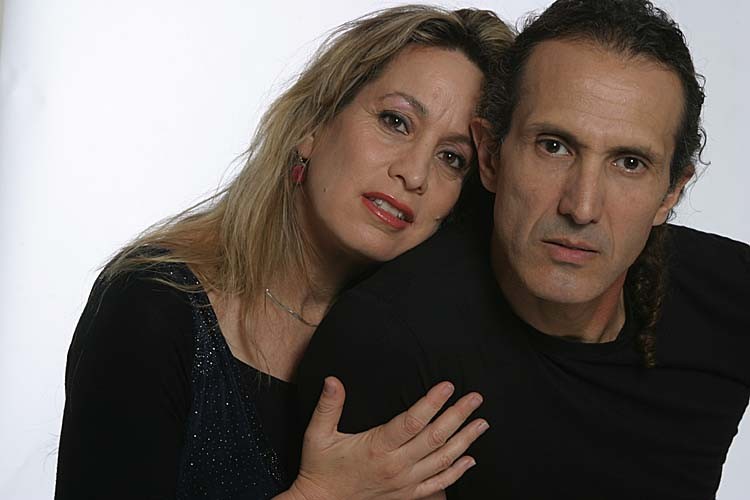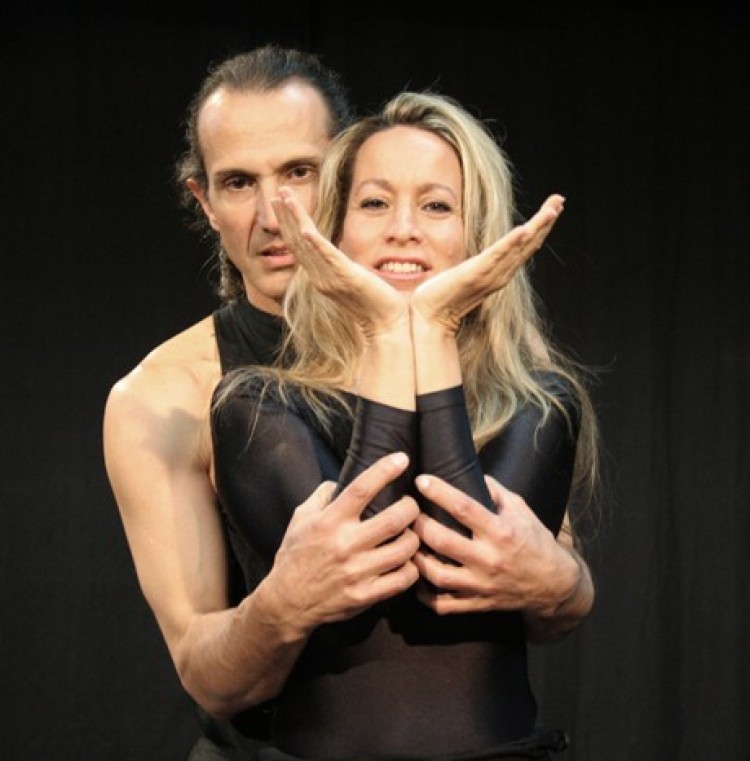For many years now, they have been performing in Israel and in other countries in a show for two, which they have created and named “Two Worlds,” but off stage they are a married couple with two children.
Amnon Damti was the lead dancer in the Israeli dancing group for the hearing-impaired “Sound and Silence.” He left it to create “Two Worlds” with Jill.
The show, composed of dance, a touch of mime, and texts, expresses the bond between the two. In the dialogue through movement between the two bodies, there is a lot of man-woman connection, support, and dependence, yet harmony and emotion are unequivocally expressed.
Amnon’s movements are sharp, focused, emitting powerfulness and decisiveness. Jill is soft, enveloping, supportive, and totally trusting. Combined, they create a new, single body that is composed of two, but moves as one.
The harmony existing between these two amiable people is reflected also in the conversation we’re having. While communication with Amnon is fluent, Jill is filling gaps and translates where needed.
I ask how it works for them while in performance, whether they bring their husband and wife rapport along onto the stage or whether there is a separation. Amnon answers that there is total separation on stage.
Jill tells how at the onset of their professional life, they integrated materials from their life as a couple into their creations. But that has changed over the years as the show relied increasingly on Amnon’s dance, while Jill contributed her narration of texts she had written.
Like a Bird
Amnon was born deaf. At the age of 4, he was sent to live in an institution for the hearing-impaired in Jerusalem, Israel. There he spent the next 10 years of his life. Quite understandably, this experience had a crucial effect on his dancing in later years, a medium that allows him to give expression to his need for freedom.
At 15, Amnon joined “Sound and Silence,” a dancing group of hearing-impaired people under the direction of Moshe Efrati. He danced in the group for 15 years and became its lead dancer.
Among the many prizes and titles he had been awarded along the years was the title Best International Deaf Dancer, awarded to him from Gallaudet University for deaf and hard-of-hearing artists in Washington, D.C. Following that event, he was invited to the White House in 1990 to perform for President H.W. Bush.
Born in the United States, Jill became a professional gymnast and water ballet dancer with dolphins. She always had an affinity for dancing, yet never studied in professionally. Amnon relates how when they decided to dance together he wanted her to study dance. “At first I tried pushing her in that direction, open that possibility for her,” he said.
Then he changed his mind and decided to integrate their two professional worlds into one, and that is how their show came to life. “Stay with the acrobatic style, and we’ll call it ‘Two Worlds,’” he then said.
And indeed, even throughout our conversation, when Amnon speaks, he uses his voice and body language. The way he moves is very lively and expressive, and one can easily forget he cannot hear. Jill is attentive, explains, and fills in only where needed, completely in sync with him, as he with her.
When I comment that I can see the high qualities of a classic ballet dancer in Amnon, Jill relates how in one of his visits to Israel, the world-renowned Russian dancer Rudolf Nureyev met Amnon and was deeply impressed.
“At the age of 10, I watched ‘Spartacus’ on television, performed by the Bolshoi Ballet from Moscow. It was then that I decided I wanted to dance, but didn’t believe I could, not being able to hear the music,” Amnon said.
“In fact, my basic training is like everyone else’s—classic, jazz, modern. The uniqueness is in the face that speaks and dances. There are so many facial expressions, it’s a universal language. It’s focused, precise, not diffused,” Amnon went on.
“In modern dance you find many movements of introversion. With me, the emphasis is on breaking outward, breaking the box. Fly freely like a bird.
“This is my reaction to the years I was kept in a closed institution, where I was not free to go out. When I left, I discovered a new world that was totally unfamiliar to me. That experience was like a bridge, a passage to a new, unknown world. It was like falling into a hole. I started from zero and dancing saved me. It opened me, and suddenly I understood myself,” Amnon said.
Two Worlds
When asked about the message of “Two Worlds,” Jill responded: “I believe everyone has his limitation. Amnon’s is an obvious one, yet he also has a wholeness that is his own. Beyond that, one can get very far when one has something to believe in. For me, Amnon’s deafness is not an issue; he’s a dancer, and by chance, also deaf.”
Amnon added: “The message of our show lies in the integration of the hearing and the deaf, how you bond, how you learn from each other. The audience can see who we are; it’s not just dancing.”
“What is the basis of a good bond?” I ask. Amnon looked at Jill, raised his hands decisively, and answered without hesitation: “Love! Openness! You talk about everything, all is open and bare.”
And Jill added: “Not to limit each other. Allow the other to be who he is. Each one of us has a world of his own, and Amnon’s soul is open to who I am both on stage and in life.”
“Two Worlds” is a show demonstrating the possibility of a harmonious connection between people from very different worlds. But Jill says that today this definition means less to her.
Could it be because during the years the two worlds have integrated and become one?
Oct. 17, Jill and Amnon Damti will perform in Brussels, Belgium, at the Open University in a symposium for equal rights.
Watch:
http://english.ntdtv.com/ntdtv_en/news_middleeast_africa/2011-07-06/two-worlds-of-dance-collide.html








